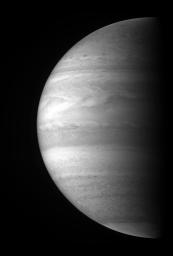
|
Jupiter’s High-Altitude Clouds
- Click the image above for a larger view
- Full-Res JPEG (2293 x 3401) (288.3 kB)
- Full-Res TIFF (2293 x 3401) (7.8 MB)
Caption:
The New Horizons Multispectral Visible Imaging Camera (MVIC) snapped this incredibly detailed picture of Jupiter's high-altitude clouds starting at 06:00 Universal Time on February 28, 2007, when the spacecraft was only 2.3 million kilometers (1.4 million miles) from the solar system's largest planet. Features as small as 50 kilometers (30 miles) are visible. The image was taken through a narrow filter centered on a methane absorption band near 890 nanometers, a considerably redder wavelength than what the eye can see. Images taken through this filter preferentially pick out clouds that are relatively high in the sky of this gas giant planet because sunlight at the wavelengths transmitted by the filter is completely absorbed by the methane gas that permeates Jupiter's atmosphere before it can reach the lower clouds.
The image reveals a range of diverse features. The south pole is capped with a haze of small particles probably created by the precipitation of charged particles into the polar regions during auroral activity. Just north of the cap is a well-formed anticyclonic vortex with rising white thunderheads at its core. Slightly north of the vortex are the tendrils of some rather disorganized storms and more pinpoint-like thunderheads. The dark "measles" that appear a bit farther north are actually cloud-free regions where light is completely absorbed by the methane gas and essentially disappears from view. The wind action considerably picks up in the equatorial regions where giant plumes are stretched into a long wave pattern. Proceeding north of the equator, cirrus-like clouds are shredded by winds reaching speeds of up to 400 miles per hour, and more pinpoint-like thunderheads are visible. Although some of the famous belt and zone structure of Jupiter's atmosphere is washed out when viewed at this wavelength, the relatively thin North Temperate Belt shows up quite nicely, as does a series of waves just north of the belt. The north polar region of Jupiter in this image has a mottled appearance, and the scene is not as dynamic as the equatorial and south polar regions.
The intricate structures revealed in this image are exciting, but they are only part of the story. The New Horizons instruments have taken images of Jupiter at approximately 260 different wavelengths, providing essentially a three-dimensional view of Jupiter's atmosphere, since images at different wavelengths probe different altitudes. New Horizons is providing a wealth of data on this fascinating planet during this last close-up view of Jupiter until the middle of the next decade.
Cataloging Keywords:
| Name | Value | Additional Values |
|---|---|---|
| Target | Jupiter | |
| System | Jupiter | |
| Target Type | Planet | |
| Mission | New Horizons | |
| Instrument Host | New Horizons | |
| Host Type | Flyby Spacecraft | |
| Instrument | Multispectral Visible Imaging Camera (MVIC) | |
| Detector | ||
| Extra Keywords | Atmosphere, Grayscale, Haze, Methane, Plume, Storm | |
| Acquisition Date | ||
| Release Date | 2007-05-01 | |
| Date in Caption | 2007-02-28 | |
| Image Credit | NASA/Johns Hopkins University Applied Physics Laboratory/Southwest Research Institute | |
| Source | photojournal.jpl.nasa.gov/catalog/PIA09339 | |
| Identifier | PIA09339 | |
